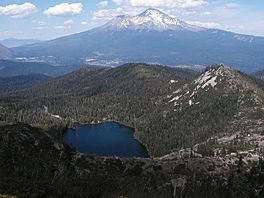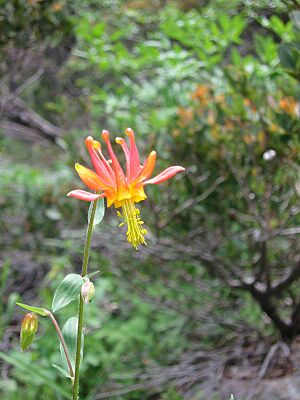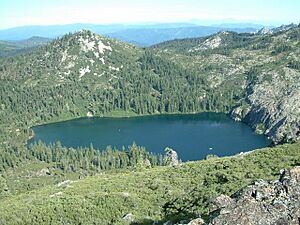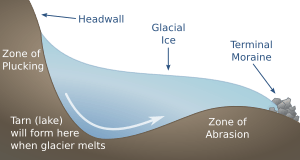Castle Lake (California) facts for kids
Quick facts for kids Castle Lake |
|
|---|---|

Castle Lake with Mount Shasta in background
|
|
| Location | Trinity Mountains, Shasta-Trinity National Forest, Siskiyou County, California |
| Coordinates | 41°13′39″N 122°23′01″W / 41.22750°N 122.38361°W |
| Type | cirque lake |
| Basin countries | United States |
| Surface area | 47 acres (19 ha) |
| Max. depth | 110 ft (34 m) |
| Surface elevation | 5,440 ft (1,660 m) |
| Settlements | Mount Shasta |
Castle Lake is a beautiful mountain lake found in the Trinity Mountains of northern California. It's located in Siskiyou County and sits west of Mount Shasta City and the famous Mount Shasta peak.
This lake is a special type called a cirque lake, which means it was carved out by a glacier long ago. Water from Castle Lake flows into Castle Lake Creek, then into Lake Siskiyou, and eventually becomes part of the Sacramento River. Most of the lake, which covers about 47 acres (19 ha), is inside the Shasta-Trinity National Forest. You can find many trails leading from the lake into the nearby Castle Crags Wilderness area, and even to Castle Crags State Park. Popular activities at Castle Lake include fishing, camping, and hiking.
Contents
Exploring Castle Lake and Its Surroundings
Castle Lake is a great place to visit, offering many outdoor activities and chances to see nature up close.
Getting to Castle Lake
You can usually reach Castle Lake by driving about 7 mi (11 km) from Lake Siskiyou. Along this road, about 3 mi (4.8 km) from the lake, you'll find Ney Springs and Faery Falls. Ney Springs was once a popular resort in the late 1800s, known for its mineral springs. A short trail leads to Faery Falls, where Ney Springs Creek drops nearly 60 ft (18 m) over a granite cliff, forming a clear pool below.
Fun Activities at the Lake
Near Castle Lake, there's a campground with 6 campsites available on a first-come, first-served basis. At the lake itself, people enjoy fishing, having picnics, and simply admiring the plants, animals, and scenery. The lake water can be cool, so swimming is usually best in the summer. You can also go kayaking, rowboating, and rafting.
In winter, when the lake freezes over, ice fishing is a common activity. You can also go cross-country skiing and snow-shoeing on the trails.
Hiking Trails Around the Lake
From the parking area, a trail about one-half mile (400 m) long follows the northern and western shores of the lake. It ends at a tall granite cliff called the headwall on the southern side. Along this trail, you'll pass the Castle Lake Limnological Research Station.
Another trail, the Little Castle Lake Trail, starts from the parking area and climbs a nearby ridge. About 1 mi (1.6 km) along this trail is Little Castle Lake, a smaller glacial lake surrounded by wildflowers in early summer. Little Castle Lake is part of the Castle Crags Wilderness Area. You can also find Heart Lake, another small lake above Castle Lake's headwall, by taking a shortcut from the Little Castle Lake Trail.
From this area, the famous Pacific Crest National Scenic Trail is only about one-half mile (1 km) away, just over the Trinity Divide. This long trail stretches all the way from Mexico to Canada, following the highest parts of the Sierra Nevada, Klamath Mountains, and Cascade Range.
The Little Castle Lake Trail continues to Mt. Bradley, a mountain that offers amazing views of Mount Shasta, Dunsmuir, California, and the upper Sacramento River canyon. This trail also connects to other trails that lead into Castle Crags State Park.
The Story of Castle Lake: How It Formed
Castle Lake was formed over 10,000 years ago during the Pleistocene Era, a time when much of North America was covered in glaciers. A glacier carved out the bowl-shaped area where the lake now sits.
Castle Lake is a classic example of a cirque lake or tarn. It's deepest, about 110 ft (34 m), near the southern, rocky part of the shore, which is called the cirque face. On the opposite side, along the northeastern shore, there's a natural dam made of boulders and gravel. This is called a terminal moraine, and it helps hold the lake's water in. Here, the lake is about 10 to 15 feet (3.0 to 4.6 metres) deep.
How Glaciers Carved the Lake
The cirque headwall (the highest part of the mountain where the glacier started) was on the south or southwest side. This area was shaded from direct sunlight and protected from strong winds. These conditions allowed snow to stay year-round, building up deeper and deeper each year.
As the snow piled up, it slowly turned into glacial ice. This ice then started to carve out a hollow in the mountain slope. This process is called nivation. As the hollow grew larger and filled with ice, rock pieces trapped within the glacier acted like sandpaper. As the glacier slowly moved downhill, it scraped and wore away the solid rock beneath it.
Over time, the hollow became a large bowl in the side of the mountain. The headwall was constantly worn down by freezing and thawing, and by a process called plucking, where the glacier pulled away chunks of rock. The basin became deeper, especially at the base of the headwall, because the ice was thickest and most powerful there.
When the climate started to warm up, the glacier began to melt and shrink. Eventually, it disappeared completely, leaving behind the deep, bowl-shaped crater. The terminal moraine, made of rocks and debris dropped by the glacier, formed a natural dam at the lake's edge. When the crater filled with water, this moraine helped to keep the water in, creating the beautiful cirque lake we see today.
Wildlife Around Castle Lake
Castle Lake and its surrounding areas are home to a wide variety of animals.
Fish and Birds
In the 1930s, people introduced fish into the lake for sport fishing. These included rainbow trout, brook trout, and golden shiner. While fish stocking stopped in 2008 to protect other species, brook trout now reproduce naturally in springs on the eastern side of the lake. Golden shiners, a type of minnow, were likely brought by anglers who left their bait behind. These fish eat tiny water creatures called zooplankton and insects, and in turn, they are eaten by predators like osprey.
Other birds you might spot include the majestic bald eagle and golden eagle, the speedy peregrine falcon, wood ducks, belted kingfishers, Steller's jays, and sooty grouse.
Reptiles, Amphibians, and Mammals
Around the lake, you can find reptiles and amphibians like the rough-skinned newt, the Cascades frog, and the garter snake. These creatures also feed on insects and young fish.
Many mammals live in the area, including black bears, blacktail deer, river otters, black-tailed jackrabbits, and mountain lions (also known as cougars or pumas). While mountain lions have been known to watch humans, there have been no reported attacks.
Plants and Flowers of Castle Lake

Even though Castle Lake is at an elevation of about 5,574 ft (1,699 m), which is below the local tree line, the plant life here is very diverse. This is because of the rocky slopes and high amount of granite. You can find everything from thick forests to areas that look almost like high-alpine regions.
Trees and Shrubs
Near and below the lake, you'll see mixed forests with trees like ponderosa pine, red fir, white fir, lodgepole pine, and incense cedar. Alder trees are also important here because they help make the soil richer. They work with tiny bacteria to take nitrogen from the air and put it into the soil, which helps other plants grow. The rare Brewer spruce can be found in a few spots on the rocky slopes behind the lake. Other trees at lower elevations include bigleaf maple, vine maple, black oak, and Pacific dogwood.
At higher, rockier spots above the lake, the forests are thinner, and the trees grow smaller. Instead, you'll find shrubs and bushes like green manzanita, dwarf mountain manzanita, and tan oak. Other shrubs around the lake include Sierra laurel, and the lake is surrounded by western azaleas, which bloom mostly in June.

Beautiful Wildflowers
The most famous plants in the area are the amazing displays of alpine and sub-alpine flowers that bloom in early summer around the lakeside and in nearby meadows. These can include wood rose, Shasta lupine, red columbine, tiger lily, fawn lily, pine-drops, Douglas spiraea, scarlet paintbrush, alpine paintbrush, dwarf paintbrush, alpine saxifrage, Shasta penstemon, alpine buckwheat, and Tofield's swamp lily. In cool, wet spots near the lake, you might even spot carnivorous Pitcher Plants!
Images for kids







